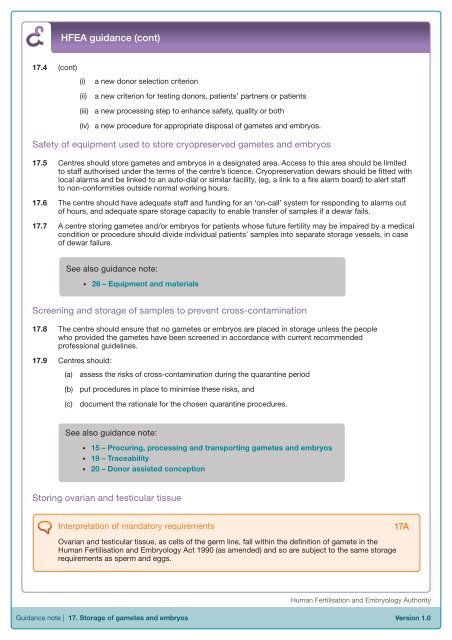Eighth Edition - R.3 - Human Fertilisation & Embryology Authority
Eighth Edition - R.3 - Human Fertilisation & Embryology Authority
Eighth Edition - R.3 - Human Fertilisation & Embryology Authority
Create successful ePaper yourself
Turn your PDF publications into a flip-book with our unique Google optimized e-Paper software.
v<br />
HFEA guidance (cont)<br />
17.4 (cont)<br />
(i)<br />
(ii)<br />
a new donor selection criterion<br />
a new criterion for testing donors, patients’ partners or patients<br />
(iii) a new processing step to enhance safety, quality or both<br />
(iv) a new procedure for appropriate disposal of gametes and embryos.<br />
Safety of equipment used to store cryopreserved gametes and embryos<br />
17.5 Centres should store gametes and embryos in a designated area. Access to this area should be limited<br />
to staff authorised under the terms of the centre’s licence. Cryopreservation dewars should be fitted with<br />
local alarms and be linked to an auto-dial or similar facility, (eg, a link to a fire alarm board) to alert staff<br />
to non-conformities outside normal working hours.<br />
17.6 The centre should have adequate staff and funding for an ‘on-call’ system for responding to alarms out<br />
of hours, and adequate spare storage capacity to enable transfer of samples if a dewar fails.<br />
17.7 A centre storing gametes and/or embryos for patients whose future fertility may be impaired by a medical<br />
condition or procedure should divide individual patients’ samples into separate storage vessels, in case<br />
of dewar failure.<br />
See also guidance note:<br />
<br />
26 – Equipment and materials<br />
Screening and storage of samples to prevent cross-contamination<br />
17.8 The centre should ensure that no gametes or embryos are placed in storage unless the people<br />
who provided the gametes have been screened in accordance with current recommended<br />
professional guidelines.<br />
17.9 Centres should:<br />
(a) assess the risks of cross-contamination during the quarantine period<br />
(b) put procedures in place to minimise these risks, and<br />
(c) document the rationale for the chosen quarantine procedures.<br />
See also guidance note:<br />
<br />
<br />
<br />
15 – Procuring, processing and transporting gametes and embryos<br />
19 – Traceability<br />
20 – Donor assisted conception<br />
Storing ovarian and testicular tissue<br />
Interpretation of mandatory requirements<br />
Ovarian and testicular tissue, as cells of the germ line, fall within the definition of gamete in the<br />
<strong>Human</strong> <strong>Fertilisation</strong> and <strong>Embryology</strong> Act 1990 (as amended) and so are subject to the same storage<br />
requirements as sperm and eggs.<br />
17A<br />
<strong>Human</strong> <strong>Fertilisation</strong> and <strong>Embryology</strong> <strong>Authority</strong><br />
Guidance note | 17. Storage of gametes and embryos<br />
Version 1.0

















